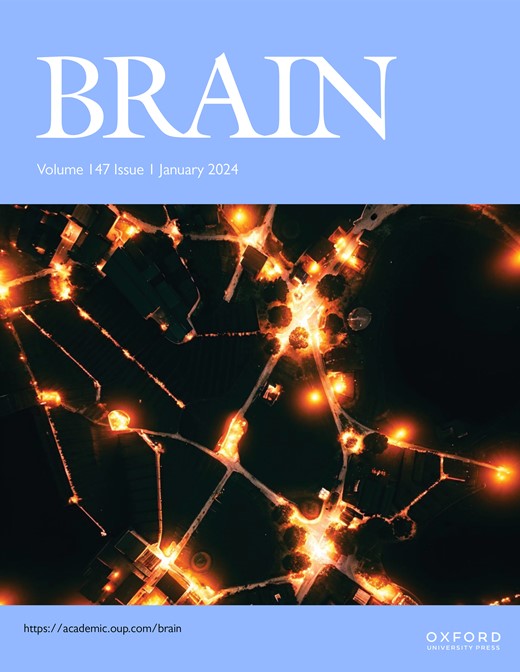内体2Cl-/H+交换器通过调节Kv7/KCNQ通道密度调节神经元兴奋性。
IF 11.7
1区 医学
Q1 CLINICAL NEUROLOGY
引用次数: 0
摘要
CLCN3和CLCN4编码内体2Cl-/H+交换体ClC-3和ClC-4,它们在中枢神经系统,包括海马形成中高度表达。最近在这些基因中发现的致病变异引起了罕见的CLCN3-和clcn4 -神经发育疾病,其特征是一系列神经和神经精神并发症,如全面发育迟缓、智力残疾、癫痫发作、行为问题和大脑异常。ClC-3和ClC-4调控神经元功能和活力的机制,以及在CLCN3和clcn4相关神经发育疾病中受影响的分子途径尚不清楚。在神经退行性疾病中,神经元树突发生病理变化,通常与异常的电活动有关。为了研究ClC-3或ClC-4缺陷如何改变神经元的兴奋性和形态,我们将膜片钳记录与同时细胞内生物细胞素填充的急性海马切片制备相结合。我们分析了Clcn3-/-和Clcn4-/-神经元的功能和结构特性。在海马体的coru amonis 2 (CA2)区域发现了两种放电模式:规则放电和突发放电。在出生后第13天(P13), 62%被评估的CA2野生型神经元表现出节律性爆裂行为;在Clcn4-/-组中,这一比例降至19%,在Clcn3-/-组中完全不存在。放电模式的变化伴随着动作电位阈值的去极化移位和动作电位后超极化期的增加。阻断Kv7/KCNQ通道,以及较小程度上阻断Kv1通道,但不阻断BK、SK或Kv2通道,再现了Clcn3-/-条件下的野生型放电模式表型。此外,我们还发现了树突树突复杂性的异常。在Clcn3-/-神经元中,顶端和基部结构域的分支和长度显著减少,而在Clcn4-/-神经元中则有中度改变。在P3阶段,我们发现25%的Clcn3-/-破裂神经元与野生型相比,树突状树突没有明显的形态学异常,这表明功能缺陷先于Cl-/H+交换体缺陷神经元的结构改变。类似地,齿状颗粒细胞表现出动作电位特性缺陷和突发放电活性降低,Kv7/KCNQ阻断基本上但不是完全挽救了这些缺陷。我们得出结论,Cl-/H+交换剂主要通过微调Kv7/KCNQ通道密度来调节神经元的电兴奋性和放电模式,功能缺陷可能导致树突形态的改变。我们的研究结果为神经元中Cl-/H+交换物的潜在分子机制提供了新的见解,并为CLCN3-和clcn4相关的Cl-/H+交换功能破坏患者的潜在治疗干预铺平了道路。本文章由计算机程序翻译,如有差异,请以英文原文为准。
Endosomal 2Cl-/H+ exchangers regulate neuronal excitability by tuning Kv7/KCNQ channel density.
CLCN3 and CLCN4 encode the endosomal 2Cl-/H+ exchangers ClC-3 and ClC-4, which are highly expressed within the central nervous system, including hippocampal formation. Pathogenic variants recently found in these genes have given rise to the rare CLCN3- and CLCN4-neurodevelopmental conditions, characterised by a range of neurological and neuropsychiatric complications, such as global developmental delay, intellectual disability as a core feature, seizures, behavioural issues, and brain abnormalities. The mechanisms by which ClC-3 and ClC-4 regulate neuronal function and viability, as well as the molecular pathways affected in CLCN3- and CLCN4-related neurodevelopmental conditions, remain unknown. In neurodegenerative diseases, neuronal dendrites undergo pathological changes often associated with aberrant electrical activity. To investigate how ClC-3 or ClC-4 deficit alters neuronal excitability and morphology, we combined patch-clamp recordings in acute hippocampal slice preparations with simultaneous intracellular biocytin filling. We analysed the functional and structural properties of Clcn3-/- and Clcn4-/- neurons. Two firing patterns are found in the hippocampus's Cornu Ammonis 2 (CA2) region: regular and burst firing. At post-natal day 13 (P13), 62% of the assessed CA2 wild-type neurons showed a rhythmic bursting behaviour; this was reduced to 19% in Clcn4-/- and completely absent in the Clcn3-/- condition. Changes in the firing patterns were accompanied by a depolarising shift in the action potential threshold and an increase in the afterhyperpolarizing phase of the action potentials. Blockade of Kv7/KCNQ, and to a lesser extent Kv1, but not BK, SK or Kv2 channels, recapitulates the wild-type firing pattern phenotype in the Clcn3-/- condition. Moreover, we detected abnormalities in the complexity of the dendritic arborisation. Branching and lengths of apical and basal domains were significantly reduced in the Clcn3-/- and moderately altered in the Clcn4-/- neurons. At P3, we found 25% of bursting neurons in Clcn3-/- with no significant morphological abnormalities in the dendritic arborisation compared to the wild-type, suggesting that functional defects precede structural changes in Cl-/H+ exchangers-deficient neurons. Similarly, dentate granule cells exhibited defective action potential properties and reduced burst-firing activity, which was substantially, but not fully rescued by Kv7/KCNQ blockage. We conclude that Cl-/H+ exchangers regulate neurons' electrical excitability and firing patterns primarily by fine-tuning Kv7/KCNQ channel density, and that functional defects might contribute to alterations in dendritic morphology. Our findings provide new insights into the underlying molecular mechanisms of Cl-/H+ exchangers in neurons and pave the way toward potential therapeutic interventions for CLCN3- and CLCN4-related patients associated with disruption of Cl-/H+ exchange function.
求助全文
通过发布文献求助,成功后即可免费获取论文全文。
去求助
来源期刊

Brain
医学-临床神经学
CiteScore
20.30
自引率
4.10%
发文量
458
审稿时长
3-6 weeks
期刊介绍:
Brain, a journal focused on clinical neurology and translational neuroscience, has been publishing landmark papers since 1878. The journal aims to expand its scope by including studies that shed light on disease mechanisms and conducting innovative clinical trials for brain disorders. With a wide range of topics covered, the Editorial Board represents the international readership and diverse coverage of the journal. Accepted articles are promptly posted online, typically within a few weeks of acceptance. As of 2022, Brain holds an impressive impact factor of 14.5, according to the Journal Citation Reports.
 求助内容:
求助内容: 应助结果提醒方式:
应助结果提醒方式:


